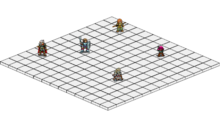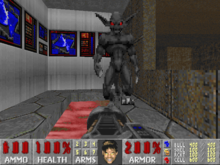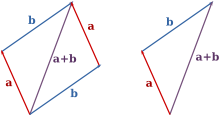Movement in computer games


The movement in computer games was in the first computer games such as Tennis for Two and Spacewar the most important game element. The interaction of player-controlled objects (tennis rackets, spaceships) and uncontrolled objects (ball, projectiles) or even self-controlling objects (UFO in asteroids ) was characteristic of the early computer games. (Perhaps the main exceptions were adventure , hack, and board game simulations like chess .)
With the introduction of jump-'n'-run games, the interaction of several moving objects was postponed in favor of control primarily of one's own character , even if other moving objects were given an important but still secondary role in the further development of this game category.
Movements in early computer games were mainly translational as in Tennis for Two , less often rotations ( Tempest ). The very early space war used the possibilities of computer technology to superimpose translations and rotations, thereby mapping the independence principle of the movements and (at least in translation) in addition to the position, the speed as the first and the acceleration as the second derivative of the position according to time. So Spacewar was a simple, but remarkably complete simulation of reality for a two-dimensional game. Also, Tennis for Two had these characteristics and also let the ball gravity (of adjustable thickness) act.
An important principle of movement in two-dimensional games, as they dominate the early era of computer games, is the "torus winding" ( English torus wrap ). The simplest way to keep objects that go beyond the edge of the screen in the game is to bring objects back into play on the opposite edge of the screen. This made the playing field the development of a torus . To illustrate: If you curve the screen so that the upper edge touches the lower edge, you get a tube, if you curve this tube so that the edges of both ends lie on top of each other, you get a torus.
Movement in 2D worlds
- horizontal scrolling
- especially jump 'n' run
- vertical
- Shooter / Shoot'n run, e.g. B. Commando , Shoot-'Em-Up Construction Kit
- Bird's eye view (not always scrolling)
- Action games, racing games
- Tactical games, e.g. B. SimCity
- isometric
- Shooter (e.g. Zaxxon )
- Tactical games (strategy, role-playing games), e.g. B. Ant Attack . (Partly round-based, partly without scrolling)
In simple or early 2D games, the player usually controls sprites or the background moves. As a rule, carried a scrolling the screen, entering thereby the character in other areas or rooms. An example of a non-scrolling game is the platform game Bomb Jack .
The movements are controlled via one or more input devices that are hardware-dependent and are constantly queried by the program. In the past, joysticks in particular were preferred, nowadays mice, keyboards and gamepads are mainly used.
Movement in 3D worlds
- Ego shooter
- Third person shooter
- 3D platformer runs
- 3D beat 'em ups
- Racing games
- Simulations like flight simulators
- Sports games and other genres
Movement in 3D worlds is more complex and is made possible using game engines and graphics engines . The 3D world has to be constantly updated when moving. This is often calculated using polygons , vectors and matrices and is usually done in real time (see in particular coordinate transformation ).
Some games also have a tracking camera, some of which can also be controlled. Depending on the genre, there are different types of movement and special features. The programmer also has to determine which areas are accessible and which are not. In addition, objects or opposing characters must be defined and the interaction with them, as well as the animations of the game characters.
Movement in first person shooters
Under movement in FPS games fall a number of ways, the character of a first-person shooter to control. The basic control options for movement are usually straight-line movement forwards, backwards, left or right (e.g. WASD keyboard layout ), rotating and changing the viewing direction ( mouse control ) and jumps.
Strafing
Strafe ( English to strafe [ ˈstreɪːf ] "bombard") or punishments (Germanized) describes the sideways movement of a pawn. For example, “punishing around the corner” does not usually describe the normal walking around the corner (running to the corner, turning, running on), but the strategic, sideways approach to a corner due to possible enemy contact behind it.
Penalty running
Some older games allow the game character to exceed the maximum speed in one direction by running forward and sideways at the same time (English straferunning ). The maximum speeds in both directions are added as vectors , and according to the Pythagorean Theorem , for example, at the same maximum speeds forwards and sideways, the diagonal movement is about 40% faster.
Penalty running is a popular practice among GoldenEye 007 and Perfect Dark players . The original Doom game was one of the first games to make penalty running possible. Most newer computer games, however, prevent this advantage and ensure that the player runs diagonally at the same speed as straight ahead.
Circle
An advantage can be gained by circling an opponent sideways - often called circle strafing . It allows for continued firing at the enemy while constantly running out of sight.
Some games offer a system to do the aiming automatically so that the player only has to walk sideways. A well-known example is the Zelda targeting system : Ocarina of Time or Metroid Prime , which fixes the game's view of the opponent when a certain button is pressed.
Trick jumps
The term trick jump can be used to summarize all jumps that are more than a simple single application of the jump command.
Probably the most famous trick jump is the rocket jump. The player aims at the ground in front of him with a rocket launcher or other explosive weapon in order to jump and fire in real time. As a result of the explosion, the player is thrown higher than he could have reached with a normal jump. The damage that the player takes with this technique depends on the timely jump. In addition, some engines use friction to slow the player down when standing on the ground; that does not occur if the player is already in the air.
Contrary to popular belief, the rocket jump did not originate in the computer game Quake (1996), although the game certainly spread the technology through the simplicity of aiming the rocket launcher at the ground in front of you. Rocket jumps already exist in Rise of the Triad (1994), where they are required to complete the last level. A horizontal rocket jump also appears in Doom (1993); it is not necessary to solve the game, but according to game developer John Romero it was the intended method.
Elevator jump
If the player goes up with an elevator, some games support that the player not only reaches the normal jump height if the player takes off in time, but is thrown even further upwards by the elevator.
Evasive jump
Some games, such as the Unreal Tournament series, allow you to perform an evasive jump ( dodging ) by quickly pressing a direction key twice , which can, for example, quickly bring the player out of the line of fire.
Penalty jump
A penalty jump is a technique in which one of the two direction keys is pressed alternately immediately after the jump, while the direction is determined with the mouse. A continuous sequence of penalty jumps gives the player an increasingly higher speed. The possibility of penalty jumps originally appeared as a bug in Quake II , but was then intentionally integrated as a dynamic movement option in the successor Quake III Arena and some other games.
Bunny hopping is a technique found in Quake engine games . The player runs through the level and repeatedly jumps off as soon as he touches the ground. This can also be combined with penalty jumps to achieve a longer jump length. Bunny hopping is also used by most of the players in the MMORPG World of Warcraft . Whether the figure increases in speed as a result is controversial.
Two different phenomena are referred to as double jump : a game behavior that is intended by the developers, in which the player can jump and jump again in midair; and behavior unintentional by the developers where the player can gain extra height by jumping, landing on a hill, and jumping again with good timing.
The intended variant occurs mainly in arcade and console games , while the unintended variant is particularly well known in the Quake series.
See also
- Computer gamer jargon
- History of video games
- Genre (computer games)
- Game programming
- Computer graphics
literature
- Kaiser, game programming in C ++ - 2D, 3D and network games ISBN 978-3898422727
Web links
- GameDev.net (English)
- “No computer game without mathematics” at Bildungsklick
- "Trick jumping: gamers make big leaps" at Spiegel Online
- International website with many animated videos ( Memento from June 12, 2013 in the Internet Archive )




